Crown Of The Rose (1526)
Share this page:
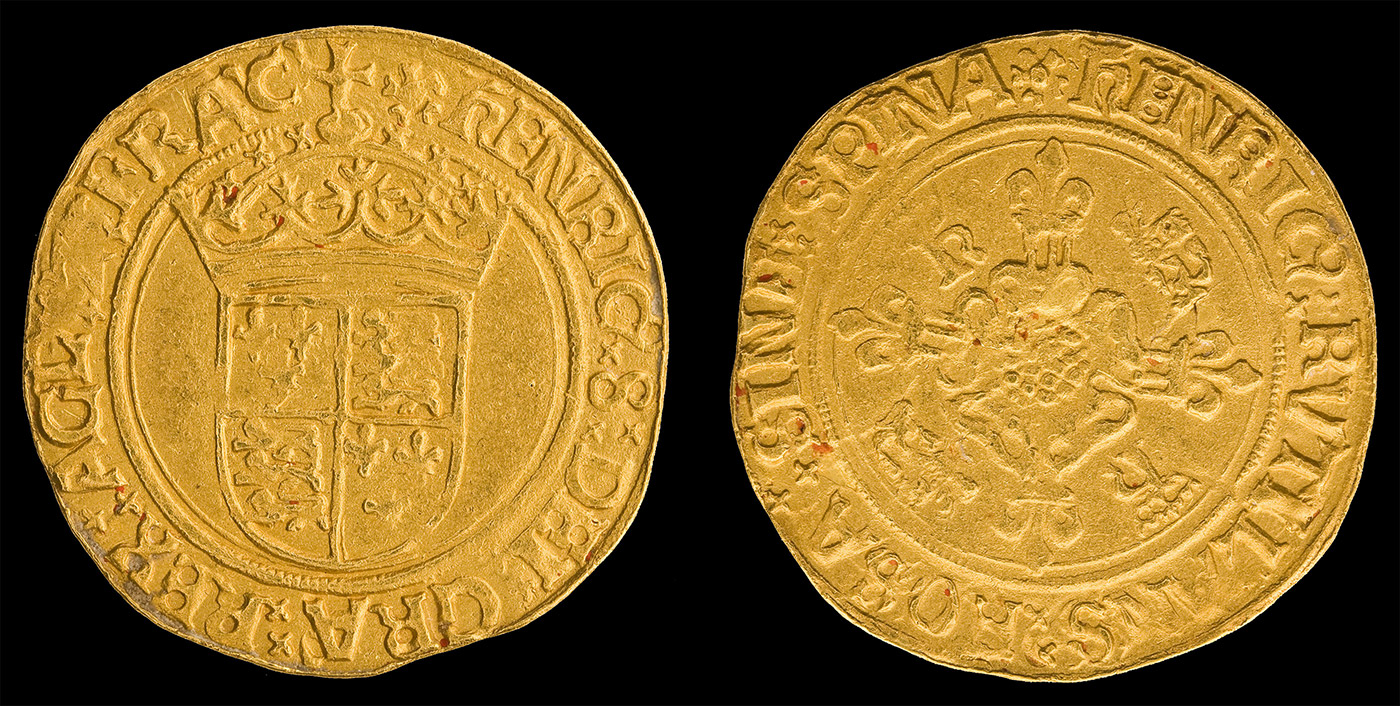
Crown Of The Rose of King Henry VIII (second coinage, 1526). ANS Collection.
History:
The first ever crown coin to be made was not silver, but gold. In 1526, the price of gold in Flanders and France was so high that English coin was being taken overseas and exchanged at considerable profit. In a bid to prevent English gold coins from being thus taken out of circulation, Henry VIII ordered the minting of this new crown coin, valued at four shillings and sixpence and manufactured using 23ct gold. The new coin, mentioned in the proclamation of Aug 22nd, 1526, was an imitation of the French "Crown of the Sun" and utilized the same fineness and value as that coin. This new coin was however not a success because it was found that the exportation of the coin in fact increased. It was also an inconvenient denomination. In a further bid to prevent export, an increase in the face value of the coins was proposed and the Crown of the Rose was shortly replaced (Nov 5th, 1526) by a new coin, the Crown of the Double Rose, which would be valued at 5 shillings.
Description:
Obverse: Crowned royal shield, with the arms of England and France quarterly, all within two inner circles, the innermost linear, the outer slightly dotted, which are pierced above by the ball and cross surmounting the crown. Mint mark: Rose.
Obverse Inscription: HENRIC 8 DEI GRA REX AGL Z FRA'C' (meaning "Henry By the grace of God King of England and France"). The stops are small crosses, of which there are two after each word except HENRIC, which has only one, and FRAC, which has no stop.
Reverse: 5-petalled single rose fixed on the centre of a cross fleury (Fleur-de-lys in four directions), with the letter H crowned in alternate quarters, and lions passant guardant in the other two.
Reverse Inscription: Spink states that there are 2 variations. DNS HIB RVTLILANS ROSA SINE SPINA (meaning "Henry VIII a dazzling rose without a thorn") (From Spink 2018 photo). HENRIC' RVTILANS ROSA SINE SPIN (BNS, 1907).
Provenance:
This coin is very rare indeed and seems to have been entirely lost for more than a century. There are presently just three known genuine specimens, two of which are in museums:
Crown of the Rose #1, discovered in or just prior to 1907, is in the museum of the American Numismatic Society in New York. Photo at top of page.
Provenance - J. Sandford Saltus; president of both the New York Numismatic Club and British Numismatic Society. http://numismatics.org/collection/1909.257.1?lang=en
http://numismatics.org/authority/saltus
Additional photo:
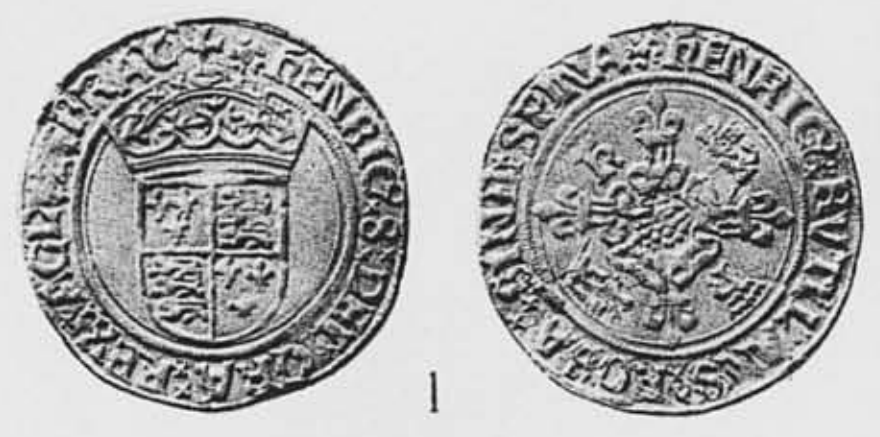
Crown Of The Rose of King Henry VIII (second coinage, 1526). This image, taken from the British Numismatic Society report of 1907, appears to be an earlier photo of the same coin
currently in the ANS museum (photo at top of page), which makes sense.
Crown of the Rose #2 is in the British Museum.
It is described as having been acquired in 1920. This coin was previously drilled to be used as a necklace medallion:
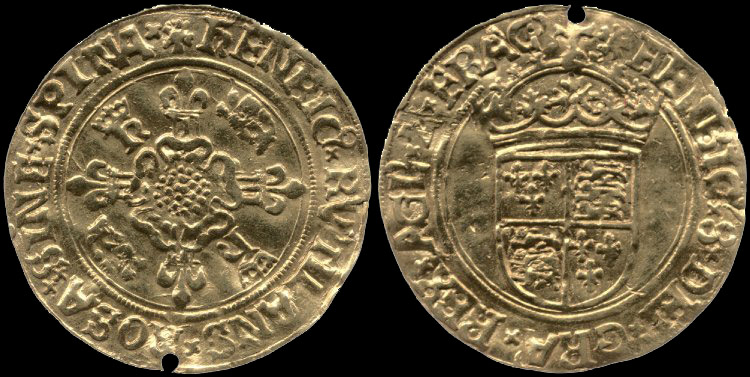
Crown Of The Rose of King Henry VIII (second coinage, 1526). Image - British Museum, lic. under CC.
https://www.britishmuseum.org/research/collection_online/collection_object_details.aspx?objectId=1067254&partId=1&searchText=1526&page=1
Crown of the Rose #3, same type as above, was reported sold to Spink of London in 1961 for £4,000 and was brought "from a man in Northumberland who had a collection of silver and gold coins, not thinking there was much of value in them". Glasgow Herald, April 15th, 1961. https://news.google.com/newspapers?nid=2507&dat=19610415&id=QBU1AAAAIBAJ&sjid=5KULAAAAIBAJ&pg=5303,6760670 Spink's example is no doubt the one appearing in their catalogue (#2272), and looks to be the finest of the three - superbly struck and with very little wear.
Cast copy: A copy of the crown of the rose, in Leeds Museum, is mentioned in BNJ 32 (1963) p.162. This piece, of pewter gilt, appears to have been cast from a genuine coin of identical die; perhaps the one in the National Collection (British Mus.)?
The "Lost" Crown Of The Rose Of Snelling And Ruding:
There may be more in existence: A further variant, clearly a distinct coin from any of the above, is described and illustrated by Snelling (1762, p.12). His illustration ("Coins of Henry VII and Henry VIII") is clearly a different coin to the one in either the BM, ANS or Spink photographs. Snelling depicts "H R" instead of "H H" and an alternate inscription on both obv (HENRIC 8 DEI GRA REX ANGL Z FRA') and rev (HENRIC VIII RVTILANS ROSA SINE SPIN). Snelling's illustration also clearly depicts a lion mint mark (92), which is fascinating because this mm is unmentioned in any of the modern catalogues. This mint mark is in fact not listed at all in Spink for coins of Henry VIII (2018, p.234), but was noted as being used by Edward VI in 1550-1 (p.246). However this is clearly a coin of Henry VIII:
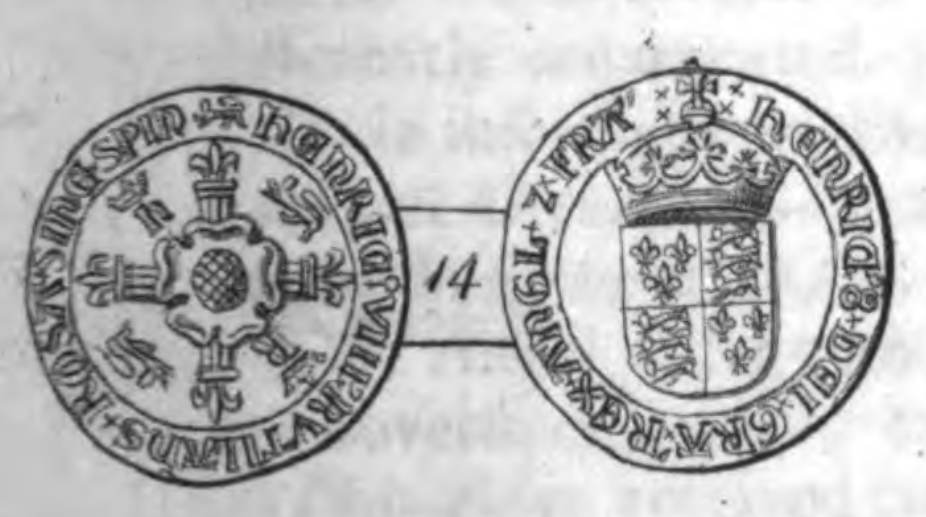
Crown Of The Rose of King Henry VIII (second coinage, 1526). Illustration - Snelling, 1762.
A very similar illustration appears in Martin Folkes' "Tables of English Silver And Gold Coins" (1763) and subsequently in Ruding, 1840, vol. 3. The reverse has the same Lion mint mark but has H in both quarters. Ruding adds the note (p.352) "This coin is not to be found in any collection [ED]" - leading us to conclude that his work copied the illustration from a previous publication and that he had not himself laid eyes upon the coin.
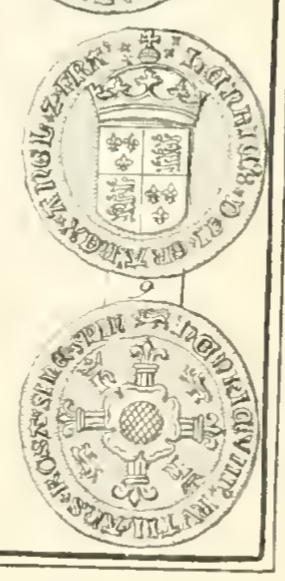
Crown Of The Rose of King Henry VIII (second coinage, 1526). Illustration - Ruding, 1840.
The coin appears to have been all but forgotten in the 19th century. Keynon, in his "The Gold Coins Of England" (1884) appears not to have noted the above descriptions of the coin and writes "The 'Crown of the Rose', mentioned in the proclamation of the 22nd August [1526], is not known and was probably never struck."
The Crown of the Rose is also conspicuous by its absence from the auction listings of the notable Montagu Collection (1896, Sotheby, Wilkinson & Hodge), which lists 6 Crowns of the Double Rose (lots 731-736) and of the Murdoch Collection (1903, Sotheby, Wilkinson & Hodge) which includes 7 Crowns of the Double Rose (lots 427-430).
Finally we find mention of it in the British Numismatic Society journal of 1907, where it (our #1 example listed above) was described as being "newly brought to light". So we have proof that it was indeed struck, and appears to have been issued, though in what quantity is unknown. Digging into historical records may reveal this information as quantities of bullion used for coin were typically recorded.
If the coins were being exported en masse and traded on the continent, they may well have ended up being melted down. The remainder may have been recalled by Henry "Old Copper Nose" VIII - who was, after all, rather fond of recalling fine coin, adding some base metal into the mix and reissuing coin of lesser fineness! (The new Crown of the Double Rose was only 22ct, the first time coin had ever been minted at below the 'standard' fineness - and had a higher face value, so there would have been an instant profit there!) We can only speculate that the coin depicted by Snelling and Ruding, evidently known to the 17th c. and early 18th c. numismatists, has been lost for at least a couple of centuries, and this lost coin, or other examples, may yet come to light, potentially making the owner very rich. Perhaps the last chapter in the history of this tantalizing, elusive coin, has not yet been written.
AN, 2019.
Crown Of The Rose - Coin Facts:
Catalogue Numbers: Spink 2272, Coincraft H8CR-005.
Mint Mark: Rose
Weight: 3.5 grams (54 grains - this would make sense as 1/100 of a Tower Pound)
Mintage: Unknown. Coin was superseded within a few months
Rarity: Extremely rare. 3 known to exist, 2 of which are in museums. VF valued (conservatively!) at £25,000 in 2018 (Spink).
Additional Notes:
• At the time of the abolishment of the Crown of the Rose (proclamation of November 5th, 1526), the Tower Pound, which consisted of 5400 grains, was abolished and the Troy Pound of 5760 grains was introduced.
• Although at first glance it might appear that Henry VIII's self-description "A dazzling rose without a thorn" might have been entirely narcissistic, it may well have been a humorous triple play on words. Instead of a royal portrait, which was a standard on coins, the rose appeared in his place, thus the king was literally a rose. It was dazzling (in 23ct gold) and had no thorn, being a coin. This legend may also have been a hint at the fact that this new coin was of high purity and would thus have no negative consequences when used for transactions.
Sources:
Kenyon - The Gold Coins of England
Spink - Coins of England (2018)
Snelling - A View Of The Gold Coin And Coinage Of England (1762)
Catalogue of the Murdoch Collection (1903, Sotheby, Wilkinson & Hodge)
"A Remarkable Gold Coin Of Henry VIII" - British Numismatic Society, 1907. https://www.britnumsoc.org/publications/Digital%20BNJ/pdfs/1907_BNJ_4.pdf
BNJ 4 (1907) p.145 https://www.britnumsoc.org/publications/Digital%20BNJ/pdfs/1907_BNJ_4.pdf
BNJ 32 (1963) p.162 https://www.britnumsoc.org/publications/Digital%20BNJ/pdfs/1963_BNJ_32.pdf
Ruding, Plates To The Annals Of The Coinage Of Great Britain, Vol 3, 1840



Privacy Policy |
Cookie Policy |
GDPR

Disclaimer - While every care was taken in the preparation of this website (www.coinandbullionpages.com) and its contents, no guarantee is made as to the suitability of this website for any purpose whatsoever, nor of the accuracy, timeliness or usefulness of its information. This website is provided for general information and entertainment purposes only and the information provided on this web site should not be seen as, nor as a substitute for, legal, business or investment advice. The website's owner specifically disclaims any and all liability arising in conjunction with the use of the materials / information herein.


